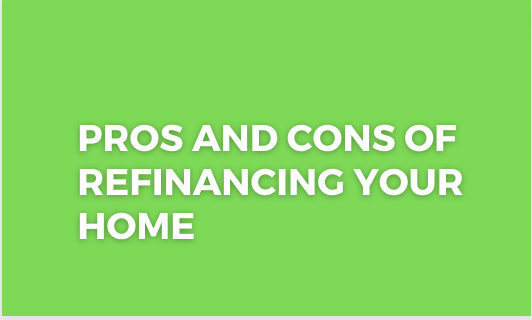Refinancing a home involves replacing an existing mortgage with a new loan, typically to obtain better loan terms or to access the home’s equity. Here are pros and cons of refinancing your home:
Pros:
- Lower Interest Rate: Refinancing can allow you to secure a lower interest rate, reducing your monthly mortgage payments and saving money over the long term.
- Cash Savings: Refinancing may provide an opportunity to save money by obtaining a lower interest rate or shorter loan term.
- Debt Consolidation: Refinancing can enable you to consolidate high-interest debt by incorporating it into your mortgage, potentially reducing overall interest costs.
- Access to Home Equity: Refinancing allows you to tap into your home’s equity and access cash for home improvements, education, or other financial needs.
- Improved Loan Terms: Refinancing can help you obtain better loan terms, such as converting from an adjustable-rate mortgage to a fixed-rate mortgage for more stability.
- Shortened Loan Term: Refinancing to a shorter loan term can help you pay off your mortgage faster, potentially saving thousands of dollars in interest.
- Lower Monthly Payments: Refinancing can extend your loan term, reducing your monthly mortgage payments and improving your cash flow.
- Eliminate Private Mortgage Insurance (PMI): If your home equity has increased, refinancing can help you eliminate the need for PMI, resulting in additional savings.
- Switching Mortgage Programs: Refinancing allows you to switch from one mortgage program to another, such as moving from an FHA loan to a conventional loan.
- Flexible Repayment Options: Refinancing can provide access to various repayment options, such as interest-only payments or adjustable-rate mortgages.
- Improved Credit Score: Consistently making mortgage payments through refinancing can help improve your credit score over time.
- Financial Planning: Refinancing can be part of a long-term financial plan, helping you optimize your mortgage to align with your goals.
- Home Value Enhancement: Refinancing funds can be used for home improvements, increasing your property’s value.
- Simplified Finances: Refinancing can simplify your finances by consolidating multiple loans or debts into a single monthly mortgage payment.
- Lower Lifetime Interest Payments: Refinancing to a lower interest rate can result in significant savings on interest payments over the life of the loan.
- Cash-Out Refinance: Refinancing can allow you to access cash through a cash-out refinance, providing flexibility for major expenses or investments.
- Financial Flexibility: Refinancing can provide financial flexibility by adjusting your mortgage terms to better align with your current circumstances.
- Opportunity for Rate Lock: Refinancing offers an opportunity to lock in a favorable interest rate, protecting against potential future rate increases.
- Favorable Market Conditions: Refinancing during favorable market conditions can lead to better loan terms and potentially more significant savings.
- Consolidation of Mortgage Servicing: Refinancing can consolidate your mortgage servicing, making it easier to manage payments and account information.
Cons:
- Closing Costs: Refinancing typically incurs closing costs, which can offset the potential savings and require upfront expenses.
- Extended Loan Term: Refinancing to a longer loan term can result in paying more interest over the life of the loan, even with a lower interest rate.
- Resetting the Clock: Refinancing restarts the clock on your mortgage, potentially increasing the overall time it takes to pay off your home.
- Qualification Requirements: Refinancing requires meeting specific qualification criteria, such as credit score, income verification, and home equity thresholds.
- Appraisal and Inspection Costs: Refinancing may require a new appraisal and home inspection, resulting in additional expenses.
- Potential Prepayment Penalty: Some mortgages include prepayment penalties, which can incur fees if you refinance before a specified period.
- Negative Equity Risk: Refinancing with low home equity may result in negative equity, making it challenging to sell or refinance in the future.
- Risk of Declining Property Value: Refinancing may be risky if your property value decreases, affecting your ability to refinance or access equity.
- Possible Rate Increase: Refinancing to an adjustable-rate mortgage can lead to higher interest rates if rates rise in the future.
- Lost Benefits of Existing Loan: Refinancing may cause you to lose benefits from your current loan, such as waived fees or unique terms.
- Prepayment of Existing Loan: Refinancing requires paying off your existing loan, potentially incurring prepayment penalties or fees.
- Temporary Dip in Credit Score: The refinancing process may temporarily lower your credit score due to credit inquiries and new accounts.
- Potential for Overborrowing: Refinancing can tempt borrowers to overborrow by accessing their home equity without considering long-term financial consequences.
- Increased Monthly Obligations: Refinancing to a higher loan amount or longer term can increase your monthly obligations and financial strain.
- Refinancing Frequency: Frequent refinancing can result in ongoing closing costs and potentially diminish the overall financial benefits.
- Loss of Interest Tax Deductions: Refinancing may eliminate or reduce the tax deductions associated with mortgage interest payments.
- Uncertain Market Conditions: Refinancing during uncertain economic conditions may introduce additional risks and uncertainties.
- Changes in Financial Circumstances: Refinancing may not be suitable if your financial circumstances have significantly changed since your original mortgage.
- Lender Requirements and Restrictions: Different lenders have varying requirements and restrictions that may impact your refinancing options.
- Potential Delays and Hassles: Refinancing involves paperwork, processing, and potential delays, requiring time and effort on the borrower’s part.
Pros
- Lower Interest Rate
- Cash Savings
- Debt Consolidation
- Access to Home Equity
- Improved Loan Terms
- Shortened Loan Term
- Lower Monthly Payments
- Eliminate Private Mortgage Insurance (PMI)
- Switching Mortgage Programs
- Flexible Repayment Options
- Improved Credit Score
- Financial Planning
- Home Value Enhancement
- Simplified Finances
- Lower Lifetime Interest Payments
- Cash-Out Refinance
- Financial Flexibility
- Opportunity for Rate Lock
- Favorable Market Conditions
- Consolidation of Mortgage Servicing
Cons
- Closing Costs
- Extended Loan Term
- Resetting the Clock
- Qualification Requirements
- Appraisal and Inspection Costs
- Potential Prepayment Penalty
- Negative Equity Risk
- Risk of Declining Property Value
- Possible Rate Increase
- Lost Benefits of Existing Loan
- Prepayment of Existing Loan
- Temporary Dip in Credit Score
- Potential for Overborrowing
- Increased Monthly Obligations
- Refinancing Frequency
- Loss of Interest Tax Deductions
- Uncertain Market Conditions
- Changes in Financial Circumstances
- Lender Requirements and Restrictions
- Potential Delays and Hassles



